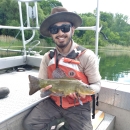Aquatic invasive species invasive species
An invasive species is any plant or animal that has spread or been introduced into a new area where they are, or could, cause harm to the environment, economy, or human, animal, or plant health. Their unwelcome presence can destroy ecosystems and cost millions of dollars.
Learn more about invasive species (AIS) are non-native (exotic) organisms, which are detrimental to native ecosystems due to their explosive range expansions and competition for food and habitat. Non-native species introductions may be intentional (stocking) or unintentional (bait, boats, canals). The office coordinates the Northeast Region AIS Program, which includes three components: coordination/technical assistance, early detection/monitoring and prevention/education. Within the Lake Ontario and Lake Erie watersheds, we conduct dedicated early detection and monitoring, control activities with partners, and work to prevent new introductions through dedicated outreach and awareness.
Invasive species management, Monitoring, Research




